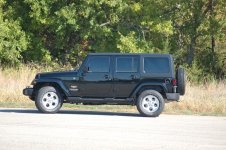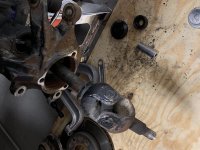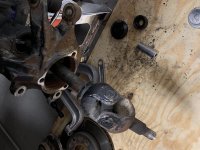BONDSY
Member
Well shortly after "The Rockin Rubicon 2010" trip, and with less than 15000mi. on the odometer, a slight shimmy in the front end indicated to me some steering issues were beginning to occur. Sure enough after some inspection, I discovered both upper ball joints had failed.
So with that being known I ordered the complete set of Dynatrac Prosteers.
****Important****
Ordering the install kit from Dynatrac will greatly aid in the install of these Prosteers.
I needed the proper press so I bought this.
KD Tools- Ball Joint Press/ Model #KDS3421
KD Tools- Ram-Jeep Adapter Set/ Model #KDS3479
Also I bought Anti-Seize, brake cleaner, red grease, wire brush, and GoJo.
Other tools you will need are:
1/2 drive Ratchet, breaker bar, torque wrench
3/8 drive ratchet, breaker bar, torque wrench
13mm 12pt. socket
19mm socket and end wrench
21mm socket
22mm socket
1 1/8" socket
1 1/16" socket
1 1/2" socket
7/8" socket
15/16" socket
Pry bar
Pickle fork, Big hammer
5mm Hex key
Giant Crescent wrench
needle nose pliers
zip ties
4 ton jack and 4 stands
BTW: This is not a definitive install write up. I'm not a certified mechanic.
I do not have a stock Jeep, so you may or may not need to do additional steps to achieve the install depending on your mods or the lack of them.
If you have a general knowledge of your Jeep it will help as I did not take pics of every step.
This is my first write up. I'll try to be thorough.
1) With a 4 ton floor jack and 6 ton stands I began my install by supporting my Jeep using the frame rails.

2) I used a 19mm deep socket loosen your lugs, jack up the axle and support the axle using two more stands, remove the wheels.
3) I used a 19mm ratchet and end wrench to remove the steering stabilizer and I taped it to the tierod.

4) Remove the cotter pins from both tierod ends. I used a 1 1/16" socket to loosen both castle nut till only a few threads remained. With a hammer I taped firmly on the top of the nut causing the tapered rod end to unseat. You could use a puller, I did not. Remove the castle nuts, set Tie rod to the side.

5) Remove cotter pin from the draglink rod end on the axle side only. I used the same 1 1/16" socket and process as the tierod to remove the draglink. Tape up out of the way. In the pic below the bottom is the tierod the top is the draglink.

This is what it will look like with the tierod end and draglink removed.

6) I used a 21 mm socket and removed the two bolts attaching the brake caliper to the steering knuckles. Gently remove the brake caliper and use a zip tie to attach it to the lower control arm. The next pic is of me tightening the bolt but you get the idea.


So with that being known I ordered the complete set of Dynatrac Prosteers.
****Important****
Ordering the install kit from Dynatrac will greatly aid in the install of these Prosteers.
I needed the proper press so I bought this.
KD Tools- Ball Joint Press/ Model #KDS3421
KD Tools- Ram-Jeep Adapter Set/ Model #KDS3479
Also I bought Anti-Seize, brake cleaner, red grease, wire brush, and GoJo.
Other tools you will need are:
1/2 drive Ratchet, breaker bar, torque wrench
3/8 drive ratchet, breaker bar, torque wrench
13mm 12pt. socket
19mm socket and end wrench
21mm socket
22mm socket
1 1/8" socket
1 1/16" socket
1 1/2" socket
7/8" socket
15/16" socket
Pry bar
Pickle fork, Big hammer
5mm Hex key
Giant Crescent wrench
needle nose pliers
zip ties
4 ton jack and 4 stands
BTW: This is not a definitive install write up. I'm not a certified mechanic.
I do not have a stock Jeep, so you may or may not need to do additional steps to achieve the install depending on your mods or the lack of them.
If you have a general knowledge of your Jeep it will help as I did not take pics of every step.
This is my first write up. I'll try to be thorough.
1) With a 4 ton floor jack and 6 ton stands I began my install by supporting my Jeep using the frame rails.

2) I used a 19mm deep socket loosen your lugs, jack up the axle and support the axle using two more stands, remove the wheels.
3) I used a 19mm ratchet and end wrench to remove the steering stabilizer and I taped it to the tierod.

4) Remove the cotter pins from both tierod ends. I used a 1 1/16" socket to loosen both castle nut till only a few threads remained. With a hammer I taped firmly on the top of the nut causing the tapered rod end to unseat. You could use a puller, I did not. Remove the castle nuts, set Tie rod to the side.

5) Remove cotter pin from the draglink rod end on the axle side only. I used the same 1 1/16" socket and process as the tierod to remove the draglink. Tape up out of the way. In the pic below the bottom is the tierod the top is the draglink.

This is what it will look like with the tierod end and draglink removed.

6) I used a 21 mm socket and removed the two bolts attaching the brake caliper to the steering knuckles. Gently remove the brake caliper and use a zip tie to attach it to the lower control arm. The next pic is of me tightening the bolt but you get the idea.























